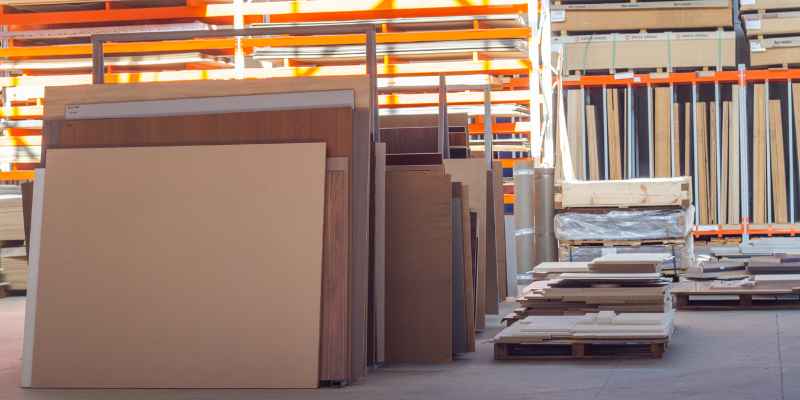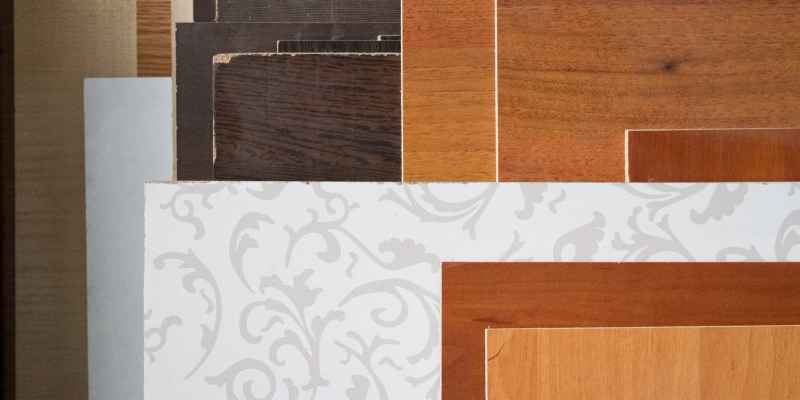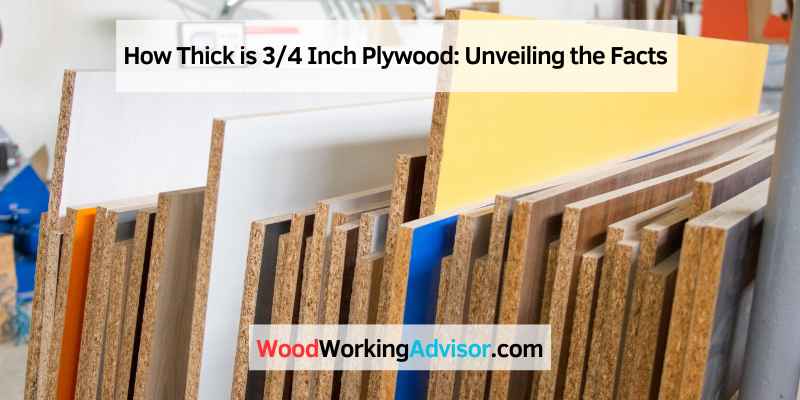3/4 inch plywood is approximately 0.75 inches thick. This thickness is commonly used for a variety of applications in construction, woodworking, and furniture making.
Plywood is a versatile material made by gluing together thin layers of wood veneer, known as plies, with each layer’s grain direction perpendicular to the one below it. The result is a strong and stable sheet that resists warping and splitting.
With its consistent thickness, 3/4 inch plywood provides a reliable base for flooring, cabinetry, shelving, and other structural elements. It is important to consider the intended use and load-bearing requirements when selecting the appropriate thickness of plywood for a project.
Introduction To Plywood Thickness
Plywood is a versatile building material used in a wide range of construction and woodworking projects. Understanding plywood thickness is crucial for selecting the right material for your project. In this article, we will explore the importance of plywood thickness, focusing on the specific dimensions of 3/4 inch plywood.
Why Thickness Matters
The thickness of plywood directly impacts its strength and suitability for different applications. Thicker plywood provides greater structural support and is ideal for projects requiring sturdiness and durability. On the other hand, thinner plywood is more flexible and lighter, making it suitable for applications where weight is a concern.
Common Uses Of 3/4 Inch Plywood
3/4 inch plywood is widely used in construction, furniture making, and other woodworking projects that require substantial strength and rigidity. Its versatility makes it a popular choice for flooring, roofing, and wall sheathing, as well as for crafting sturdy furniture pieces such as tables, cabinets, and shelving units.
Measuring Plywood Thickness
Measuring plywood thickness is a crucial aspect of any woodworking or construction project. Understanding the actual dimensions of 3/4 inch plywood is essential for ensuring the accuracy and stability of the final structure. Let’s explore the tools and techniques, as well as the importance of accuracy in measurements when determining the thickness of 3/4 inch plywood.
Tools And Techniques
When measuring the thickness of 3/4 inch plywood, it’s essential to use the right tools and techniques. Here are some commonly used tools and techniques for accurately determining the thickness of plywood:
- Vernier caliper
- Digital caliper
- Standard ruler or tape measure
- Stacking method to measure multiple sheets
Accuracy In Measurements
Ensuring precision in measurements is crucial when determining the thickness of 3/4 inch plywood. Even a slight deviation in measurement can lead to inaccuracies in the final dimensions of the project. To achieve accuracy, it’s important to:
- Calibrate and verify the measuring tools regularly
- Measure at multiple points across the plywood sheet
- Take into account any deviations caused by warping or uneven surfaces
- Record and cross-verify the measurements for consistency
The Reality Of 3/4 Inch Plywood

Nominal Vs. Actual Thickness
When it comes to plywood, the nominal thickness is often different from the actual thickness. In the case of 3/4 inch plywood, the nominal thickness refers to the initial measurement, which is slightly different from the actual thickness. This can lead to confusion for consumers, so it’s important to understand the distinction between nominal and actual measurements.
Factors Affecting Thickness
Several factors can affect the actual thickness of 3/4 inch plywood. The type of wood used in the plywood, the manufacturing process, and environmental conditions can all contribute to variations in thickness. It’s essential to consider these factors when selecting and working with 3/4 inch plywood to ensure that it meets the specific requirements of your project.
Variations Across Brands
Plywood thickness can vary across different brands, so it’s important to check specifications carefully. A 3/4 inch plywood sheet can range in actual thickness from 23/32 to 3/4 inch.
Brand Comparisons
When it comes to plywood, thickness is an important factor to consider, especially if you’re working on a construction or DIY project. 3/4 inch plywood is a popular choice due to its sturdiness and durability. However, it is important to note that the thickness of 3/4 inch plywood can vary across different brands.
Quality And Thickness Correlation
The thickness of plywood is directly related to its quality. The thicker the plywood, the higher the quality and durability. In general, 3/4 inch plywood should measure at least 0.703 inches thick. However, the thickness can vary depending on the brand and manufacturing process. It’s important to choose a reputable brand that offers consistent thickness and quality across their products.
Comparing Thickness Across Brands
To help you compare the thickness of 3/4 inch plywood across different brands, we’ve compiled a table with some popular options. Keep in mind that this is just a general guide and actual thickness may vary slightly.
| Brand | Thickness |
|---|---|
| ACX Plywood | 0.703 inches |
| Baltic Birch Plywood | 0.75 inches |
| Columbia Forest Products | 0.718 inches |
| Douglas Fir Plywood | 0.733 inches |
| Hickory Plywood | 0.703 inches |
When choosing 3/4 inch plywood, it’s important to consider the brand and its reputation for quality and consistency. By doing your research and comparing thicknesses, you can ensure that you’re getting the best product for your project.
Impact Of Moisture On Thickness
Moisture can significantly impact the thickness of 3/4 inch plywood. Understanding the effects of moisture content on plywood is crucial for preventing swelling and warping.
Maintenance Is Key
High moisture content can cause 3/4 inch plywood to swell and lose its structural integrity. Regular maintenance is essential to prevent damage.
Preventing Swelling And Warping
- Avoid exposing plywood to excessive moisture levels.
- Store plywood in a dry, well-ventilated area.
- Seal the edges of plywood to minimize moisture absorption.
- Apply a protective finish to shield plywood from moisture.
Choosing The Right Thickness For Your Project

Choosing the right thickness of plywood for your project can be a daunting task, especially if you are not familiar with the different types of plywood available in the market. However, knowing the strength and durability needs of your project and considering the weight of the plywood can help make the selection process easier. In this post, we’ll explore the thickness of 3/4 inch plywood and provide insights on how to choose the right thickness for your project.
Strength And Durability Needs
When selecting the thickness of plywood for your project, it is essential to consider the strength and durability requirements. The thicker the plywood, the stronger and more durable it is. Therefore, if your project involves heavy-duty applications, such as flooring, roofing, or wall sheathing, 3/4 inch plywood is an excellent choice. This thickness can withstand heavy loads and resist wear and tear, making it a popular choice for construction projects.
Weight Considerations
While strength and durability are essential considerations, the weight of the plywood is also an important factor to consider, especially if your project involves transportation or installation. Generally, the thicker the plywood, the heavier it is, and this can make it difficult to handle and transport. If your project involves cabinets, furniture, or other applications where weight is a concern, you may want to consider thinner plywood options. However, if your project requires the strength and durability of 3/4 inch plywood, you may need to plan for extra help or specialized equipment to handle the weight.
Overall, choosing the right thickness of plywood for your project requires careful consideration of the strength and durability needs, as well as the weight of the plywood. By taking these factors into account, you can select the right thickness of plywood to ensure the success of your project.
Installation Tips For 3/4 Inch Plywood
3/4 inch plywood is approximately 18mm thick and is commonly used in various construction projects. When installing 3/4 inch plywood, ensure proper support and fastening to prevent sagging or buckling over time. Use appropriate tools and techniques for a sturdy and durable finish.
Cutting Techniques
Precision cuts ensure accurate fit
Use a circular saw for straight cuts.
Fastening And Finishing
Pre-drill holes to prevent splitting
Secure plywood with screws or nails.
Apply wood filler before sanding for smooth finish.
Future Trends In Plywood Thickness
The future trends in plywood thickness are shaping the industry with innovations in manufacturing and a focus on sustainability. Let’s explore how these trends are influencing the standard measurements of plywood, such as how thick is 3/4 inch plywood.
Innovations In Manufacturing
Manufacturers are implementing advanced techniques to create plywood of varying thicknesses. These innovations cater to diverse construction needs and enhance structural strength.
Sustainability And Thickness
The industry is moving towards eco-friendly practices, resulting in thinner plywood that maintains durability. Sustainable sourcing and production methods are key to this trend.
Frequently Asked Questions
How Thick Is 3/4 Inch Plywood?
Plywood thickness is measured in fractions of an inch, so 3/4 inch plywood is exactly 0. 75 inches thick. It is a popular choice for various applications due to its strength and durability. This thickness is commonly used in construction, furniture making, and other woodworking projects that require a sturdy and reliable material.
Conclusion
Understanding the thickness of 3/4 inch plywood is crucial for your projects. It’s a versatile material that offers strength and durability. Knowing its exact measurements helps you plan and execute woodworking tasks effectively. Utilize this knowledge to create sturdy and long-lasting structures with ease.


